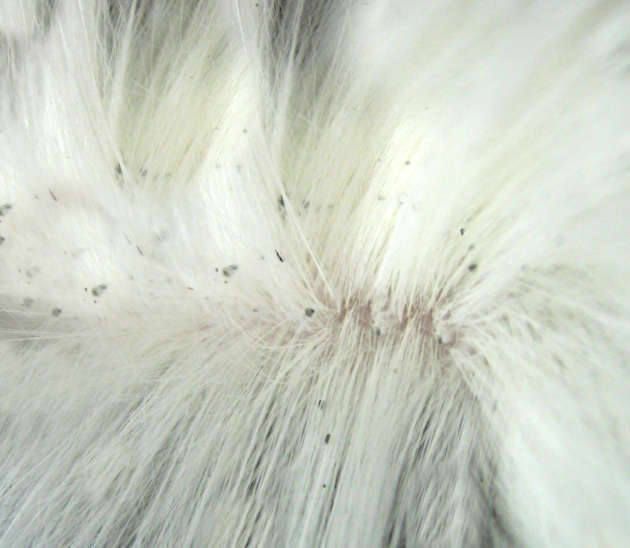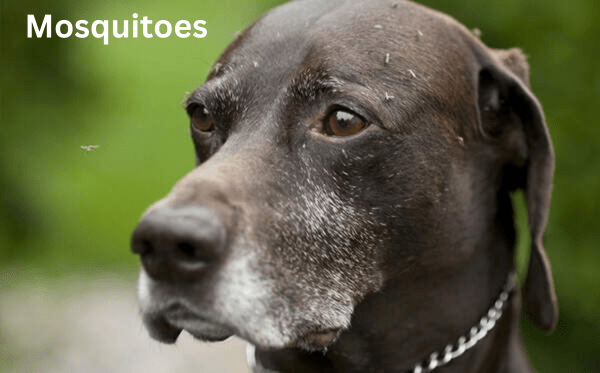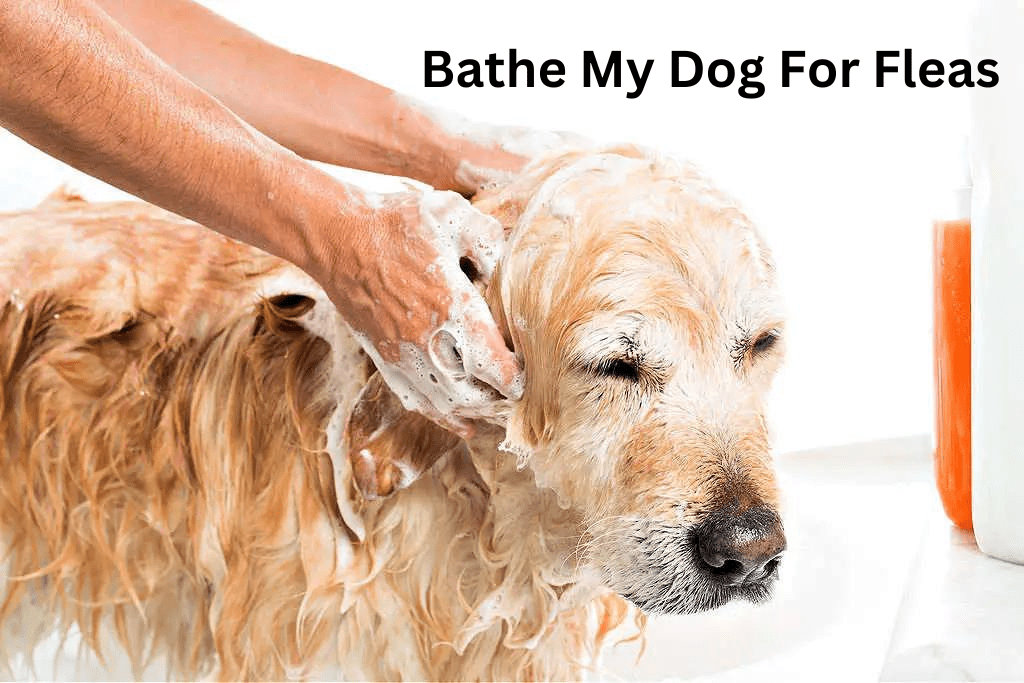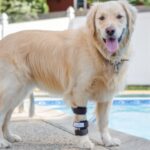Small black bugs on dogs, you might be wondering what they are and how to get rid of them. Depending on the type of bug, they could be harmless or harmful to your dog’s health and well-being.
In this article, we will discuss 8 common types of little black bugs on a dog belly that can be found on dogs, how to identify them, and what to do about them.
Contents
Different types of small black bugs on dogs.
Fleas
Fleas are one of the most common and annoying pests that can infest dogs. These are microscopic, wingless insects that consume their hosts’ blood as food. They can cause itching, irritation, allergic reactions, and anemia, and transmit diseases and parasites to dogs. Fleas can also infest your home and other pets.
To identify fleas: look for little black or brown spots that move quickly on your dog’s fur. You may also see flea dirt, which are the droppings of fleas, that look like black pepper or coffee grounds. To confirm the presence of fleas, use a flea comb to brush your dog’s fur and check for fleas or flea dirt on the comb or a white paper towel.
To get rid of fleas: you need to treat your dog, your home, and your environment. For your dog, you can use flea medications, such as topical spot-on treatments or oral tablets, that kill fleas and prevent them from reproducing.
You should also bathe your dog with a flea shampoo and comb out any remaining fleas or flea dirt. For your home, you need to vacuum thoroughly, wash all bedding and fabrics, and use flea sprays or foggers to kill any fleas or eggs. For your environment, you need to mow your lawn, remove any debris, and use flea treatments for your yard or garden.
Ticks
Ticks are another type of parasitic insect that can attach themselves to dogs and feed on their blood. They can carry and transmit serious diseases, such as Lyme disease, Rocky Mountain spotted fever, and ehrlichiosis, to dogs and humans. Ticks can also cause skin irritation, inflammation, and infection at the bite site.
To identify ticks: look for small, round, dark brown, or black bugs attached to your dog’s skin, usually in areas with less hair, such as the ears, neck, armpits, or groin. You may also see a red ring or rash around the tick bite, which is a sign of Lyme disease.
To confirm the presence of ticks, use a pair of tweezers or a tick removal tool to gently pull the tick out of your dog’s skin, making sure to remove the entire tick, including the head and mouthparts.
To get rid of ticks: you must remove them as soon as possible and dispose of them safely. You can either flush them down the toilet, drown them in alcohol, or seal them in a plastic bag. You should also clean the bite area with soap and water and apply an antiseptic.
You should monitor your dog for any signs of illness, such as fever, lethargy, loss of appetite, lameness, or swollen lymph nodes, and consult your vet if you notice any symptoms. You can also prevent ticks by using tick repellents or preventives for your dog, such as collars, sprays, or spot-on treatments, and by avoiding tick-infested areas, such as woods, grasslands, or bushes.
Lice
Lice are wingless insects that live on the hair and skin of dogs and feed on their blood or skin debris. They can cause itching, irritation, hair loss, and skin infections in dogs. Lice are species-specific, meaning they only affect dogs and cannot be transmitted to humans or other animals.

To identify lice: look for small, flat, gray, or white bugs that cling to your dog’s hair shafts. You may also see nits, which are the eggs of lice, that look like white or yellow specks attached to the hair. To confirm the presence of lice, use a fine-toothed comb to brush your dog’s fur and check for lice or nits on the comb or a white paper towel.
To get rid of lice: you need to treat your dog and your environment. For your dog, you can use lice medications, such as shampoos, sprays, or powders, that kill lice and nits. You should also trim your dog’s hair, especially in areas with heavy infestation, and comb out any remaining lice or nits.
For your environment, you need to wash and disinfect all bedding, clothing, brushes, and toys that your dog has come in contact with, and vacuum your carpets and furniture.
Flea Beetles
Flea beetles are small, shiny, black beetles that feed on plants and can occasionally be found on dogs. They are not parasitic and do not bite or harm dogs, but they can cause minor irritation or allergic reactions in some dogs. Flea beetles can also damage your plants by chewing holes in the leaves or stems.
To identify flea beetles: look for small, oval, black bugs that jump when disturbed. They are usually found on plants, such as vegetables, fruits, or flowers, but they can also hitch a ride on your dog’s fur. To confirm the presence of flea beetles, inspect your plants for any signs of damage, such as holes, spots, or wilting.
To get rid of flea beetles: you need to control them on your plants and your dog. For your plants, you can use insecticides, such as sprays or dusts, that kill flea beetles and prevent them from laying eggs.
You can also use natural methods, such as planting garlic, mint, or basil around your plants, or using sticky traps or diatomaceous earth to catch or repel flea beetles. For your dog, you can simply brush off any flea beetles that you find on their fur, or bathe them with a mild shampoo and rinse them well.
Other Types of Small Black Bugs on Dogs
Other types of tiny black bugs can be found on dogs, such as
Black ants: Some species of ants can bite or sting dogs, causing pain, swelling, or itching. You can remove them by brushing them off or using a cold compress on the affected area. You can also use ant repellents or baits to keep them away from your home or yard.
Mosquitoes: Mosquitoes can bite dogs and cause itching or allergic reactions. They can also transmit heartworm disease, which is a serious and potentially fatal condition that affects the heart and lungs of dogs. You can prevent mosquito bites by using mosquito repellents or preventives for your dog, such as collars, sprays, or spot-on treatments, and by avoiding areas with stagnant water or high mosquito activity.

Kissing bugs: Kissing bugs are blood-sucking insects that can transmit Chagas disease, which is a chronic and potentially fatal condition that affects the heart and nervous system of dogs and humans. Kissing bugs usually bite dogs around the mouth, eyes, or ears, causing swelling, redness, or itching. You can prevent kissing bug bites by using insect screens or nets on your windows and doors, and by keeping your dog indoors at night.
How to Deal with Fleas on Your Dog
Should I pick fleas off my dog?
Picking fleas off your dog is not a very effective or efficient way to get rid of them. Fleas are very small and fast, and they can easily hide in your dog’s fur. You may not be able to see or catch all of them, and you may also miss their eggs or larvae, which can hatch and reinfest your dog.
Picking fleas off your dog can also cause stress and discomfort to your dog, and increase the risk of infection or inflammation at the bite site. Instead of picking fleas off your dog, you should use a flea comb to brush your dog’s fur and remove any fleas or flea dirt that you find.
Flea dirt is the droppings of fleas, which look like black pepper or coffee grounds. You should also use a flea medication, such as a topical spot-on treatment or an oral tablet, that kills fleas and prevents them from reproducing. You should also treat your home and your environment to eliminate any fleas or eggs that may be lurking there.
How do I bathe my dog for fleas?
Bathing your dog for fleas can help to reduce the number of fleas on your dog and soothe their skin. However, bathing alone is not enough to get rid of fleas completely. You should also use a flea medication and treat your home and your environment as mentioned above.
To bathe your dog for fleas, you should use a flea shampoo that contains ingredients that kill fleas, such as pyrethrin, permethrin, or fipronil. You should follow the instructions on the label and apply the shampoo to your dog’s wet fur, avoiding the eyes, nose, and mouth.
You should massage the shampoo into your dog’s fur and skin, and leave it on for the recommended time, usually 10 to 15 minutes. You should then rinse your dog thoroughly with warm water and dry them with a towel. You should also comb your dog’s fur with a flea comb and remove any remaining fleas or flea dirt.

Are fleas bad for dogs?
Fleas are bad for dogs for several reasons. Fleas can cause
Itching, irritation, and allergic reactions: Fleas can make your dog scratch and bite their skin, which can lead to redness, inflammation, and infection. Some dogs may also be allergic to flea saliva, which can cause severe itching, swelling, and hives.
Anemia: Fleas can consume a lot of blood from your dog, which can lead to anemia, a condition where your dog has a low number of red blood cells. Anemia can cause weakness, lethargy, pale gums, and breathing difficulties in your dog.
Diseases and parasites: Fleas can transmit diseases and parasites to your dog, such as tapeworms, bacterial infections, and plague. Some of these diseases and parasites can also affect humans, such as cat scratch disease and typhus.
Suggested: Is Chalk Toxic To Dogs?
My Dog Needs Stitches But I Can’t Afford It
How do you make homemade flea killers for dogs?
There are some natural remedies that you can use to make homemade flea killers for dogs. However, you should be careful and consult your vet before using any of these remedies, as some of them may be toxic or harmful to your dog or other pets. Some of the homemade flea killers that you can try are:
Vinegar: Vinegar is acidic and can repel fleas. You can make a vinegar spray by mixing one part vinegar and one part water in a spray bottle. You can spray this solution on your dog’s fur, avoiding the eyes, nose, and mouth. You can also add some vinegar to your dog’s drinking water, but only a small amount, as too much vinegar can upset your dog’s stomach.
Lemon: Lemon contains citric acid, which can kill fleas. You can make a lemon spray by boiling a sliced lemon in water and letting it steep overnight. You can spray this solution on your dog’s fur, avoiding the eyes, nose, and mouth. You can also rub a lemon slice on your dog’s skin, but be careful not to irritate any wounds or cuts.
Baking soda: Baking soda can dehydrate and suffocate fleas. You can make baking soda powder by mixing one part baking soda and one part salt in a bowl. You can sprinkle this powder on your dog’s fur and rub it into their skin. You can also sprinkle this powder on your carpets, furniture, and bedding, and vacuum them after a few hours.
Is flea dirt harmful to humans?
Flea dirt is not harmful to humans, as it is just the feces of fleas. However, flea dirt can indicate that your dog has fleas, which can be harmful to humans. Humans are susceptible to allergic responses, itching, and discomfort from flea bites.
Fleas can also transmit diseases and parasites to humans, such as tapeworms, bacterial infections, and plague. Therefore, you should get rid of fleas on your dog and in your home as soon as possible, and wash your hands after handling your dog or any flea-infested items.
Conclusion
Small black bugs on dogs can be a nuisance or a threat to your dog’s health and well-being. It is important to identify the type of bug and take the appropriate steps to get rid of them and prevent them from coming back.
If you are unsure about the type of bug or the severity of the infestation, you should consult your vet for advice and treatment. Your dog will thank you for keeping them bug-free and happy.
FAQs on small black bugs on dogs
Q: What are the most common types of small black bugs on dogs?
- A: The most common types of small black bugs on dogs are fleas, ticks, lice, flea beetles, and ants. These bugs can cause itching, irritation, allergic reactions, anemia, and diseases in dogs.
Q: How can I tell if my dog has fleas or flea dirt?
- A: Fleas are tiny, wingless insects that feed on the blood of dogs. Flea dirt is the droppings of fleas, which look like black pepper or coffee grounds. To check for fleas or flea dirt, use a flea comb to brush your dog’s fur and look for small black or brown spots that move quickly or stick to the comb. You can also place a white paper towel under your dog and rub their fur to see if any flea dirt falls off.
Q: How can I get rid of small black bugs on dogs?
- A: The best way to get rid of small black bugs on dogs depends on the type of bug. For fleas, ticks, and lice, you should use a vet-recommended medication, such as a topical spot-on treatment or an oral tablet, that kills the bugs and prevents them from reproducing. You should also bathe your dog with a flea shampoo and comb out any remaining bugs or dirt. For flea beetles and ants, you can simply brush them off or bathe your dog with a mild shampoo. For all types of bugs, you should also treat your home and your environment by vacuuming, washing, and using insecticides or natural remedies to eliminate any bugs or eggs.
Q: How can I prevent tiny black bugs on dogs?
- A: To prevent small black bugs on your dog, you should limit the amount of time your dog spends outdoors, especially in areas with high bug activity, such as woods, grasslands, or bushes. You should also limit contact with wild and stray animals that may carry bugs. You should use bug repellents or preventives for your dog, such as collars, sprays, or spot-on treatments, that repel or kill bugs and prevent them from reproducing. You should also bathe and brush your dog regularly, and use a flea comb to check for bugs or dirt. You should also wash and disinfect all bedding, clothing, brushes, and toys that your dog has come in contact with, and vacuum your carpets and furniture.
Q: Are little black bugs on dogs harmful to humans?
- A: Some small black bugs on dogs can be harmful to humans, while others are not. Fleas, ticks, and lice are species-specific, meaning they only affect dogs and cannot be transmitted to humans or other animals. However, they can still bite humans and cause itching, irritation, or allergic reactions. They can also transmit diseases and parasites to humans, such as tapeworms, bacterial infections, and plague. Flea beetles and ants are not parasitic and do not bite or harm humans, but they can cause minor irritation or allergic reactions in some people. Mosquitoes and kissing bugs can bite humans and cause itching or allergic reactions. They can also transmit diseases to humans, such as heartworm, Chagas disease, and malaria.




